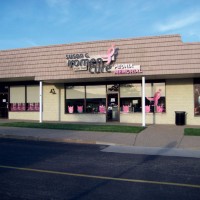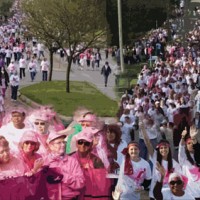Voices
Race for the Cure
Peoria has a more personal stake in the drive to cure breast cancer
Every 67 seconds somebody dies of breast cancer. A gruesome statistic for sure, but one that would no doubt be far worse if not for a promise one woman made to her sister more than 30 years ago.
That promise from Nancy Brinker to Susan G. Komen has resulted in millions of dollars raised and a many advances made in learning how to treat the dreaded disease — something that should never be overlooked when fretting about which organizations Susan G. Komen for the Cure is funding or whether its staff is staying or going.
"We just want to focus on the continuum of care for breast cancer. That's what we do best, what we've always done. Any grants we make or money we give is for that purpose and always will be," said Eric Brinker, son of Susan G. Komen for the Cure founder Nancy Brinker and a member of the organization's board of directors.
"We are just trying to save lives and find better ways to treat and, we hope, cure breast cancer," added Gina Morss-Fischer, director of development for Susan G. Komen for the Cure – Peoria Memorial office. "People all over the country have been touched by breast cancer. We make them feel empowered to do something by the activities we do, particularly the races."
She was referring to the Race for the Cure, the annual event started by Komen for the Cure nearly 30 years ago in Dallas, Texas. The second race was in Peoria and this year's event, as usual the Saturday before Mother's Day, will be the 27th annual Peoria Race for the Cure.
For many years it was the largest women-only Race for the Cure in the country and still ranks among the top, Morss-Fischer said.
"It's a little more personal here, of course, since Susan Komen lived here and she and Nancy Brinker were raised here. When we read Nancy's book about the promise she made to her sister we were able to relate to a lot of things she wrote about Peoria. Then again, that's what Peoria is all about, helping others," she said.
Sara Oakford is the chairwoman of this year's race, which again starts at Metro Centre at 7 a.m. on May 12. That site is special because Marvin Goodman, father of Komen and Brinker, started Metro Centre and owned it until his death several years ago. Eric Brinker now owns and operates Metro Centre.
The entire Komen for the Cure organization was affected by the debacle surrounding its decision to no longer fund grants to Planned Parenthood. The organization was emphatic it was not politically motivated but was done because Planned Parenthood was being investigated by federal authorities. Still, it faced a firestorm by pro-choice advocates. Then it got hit by pro-life advocates when it reversed the decision even though Komen for the Cure grants are used solely for helping women get mammograms that otherwise would not be able to afford them.
The true test of the impact that situation had on the organization may come with how many enter the various Races for the Cure, Morss-Fischer said. At press for this edition a final count of entrants to the Peoria race was not known. The 15,000-plus that ran in the 2011 was the most to date and it raised nearly $1 million.
The Peoria office did not grant funds to Planned Parenthood, she said, largely because it was never asked to. The local office decides grants on merit and they are used for screening, early detection and awareness.
Brinker said support among the organization's vast number of volunteers has not waned as a result of that situation. "Those volunteers see the benefits of what we are doing," he said.
He added that Komen for the Cure sometimes gets criticized for some of the marketing it does and spending money to do the marketing. That organization has some of the most visible and well-known marketing in the world with the pink ribbons. "We don't apologize for the marketing we do if it gets the message out there," he said.
Morss-Fischer said some also believe the organization should put all its money toward research to find the causes of the disease. "But what does that say to those people in the midst of a breast cancer crisis? We need to think of them, too," she said.
Brinker said 75 percent of all money raised by local affiliates is kept within that affiliate for those grants; the rest is earmarked for research. To date more than $8.4 million has stayed in central Illinois as a result of the Peoria race and in 2011 the Peoria Memorial affiliate awarded $765,784 in grants to local agencies and mission programs.
The largest of those local grants was $100,452 to Methodist Medical Center Foundation so it could focus on increasing the number of African-American women who get screened for breast cancer. The reason Methodist gave in its application was the discovery that African-American women tend to not be diagnosed with the disease until it is already in its later stages.
Morss-Fischer said she did not know why that is. "The 'why' is much less important than doing something to change that statistic. It's already been proven that when you catch the disease early the survival rates are better," she said.
Brinker said Komen for the Cure believes it's important for people to know where the money goes. "Some people think the percentages of where the money goes should be reversed but we are unapologetic for our continuing emphasis on early detection. Mammography is still the most accessible and successful detection tool we have," he said, adding that the organization helped more than 700,000 women get mammograms in 2011.
"Yes, research to find better treatments and even a cure is important, but our increasing ability to catch the disease early has led to a tremendous survival rate," he said. According to the organization the five-year survival rate for breast cancer is now 98 percent; in 1982, the year Komen for the Cure was founded, it was 74 percent. There are more than 2.5 million breast cancer survivors in the United States today, the largest group of cancer survivors in the country.
The Peoria affiliate covers 36 counties, stretching border to border going east to west, going as far north as Bureau and LaSalle counties and as far south as Fayette County. The population coverage is well over a million people, Morss-Fischer said.
Last year the Peoria affiliate added the McLean County Race for the Cure in Bloomington and the second race there is scheduled for Sept. 8. Morss-Fischer said races may someday be scheduled in Springfield and Champaign-Urbana and other cities in the region.
Last year marked the start of a new emphasis on team-building for fundraising purposes and Brinker and Morss-Fischer both talked about building on the momentum started with last year's race.
"That's really getting to the grassroots level. We are grateful for every penny, nickel and dime we get. And we're grateful for our corporate partners who are helping us do some important work across the world. It doesn't matter where, our focus is on vulnerable women and those partners help us reach more of them," he said. Caterpillar Inc. became one of the Komen for the Cure's partners last year.
"Last year we were only able to fund 50 percent of the grant requests we got. Our goal this year and every year now is to fund 100 percent," he said.
Morss-Fischer said she is confident Peorians will come through. "Sometimes I think this community doesn't see just how special, how giving it is. Start with Nancy Brinker. She did this because of the values she learned growing up here. Go further back; there was a reason Danny Thomas sought out Jim Maloof for the St. Jude Midwest Affiliate. He knew Peorians will dig deep, that when given a task we do it.
"It's important, however, that we don't become complacent. There is still far too much to do."



